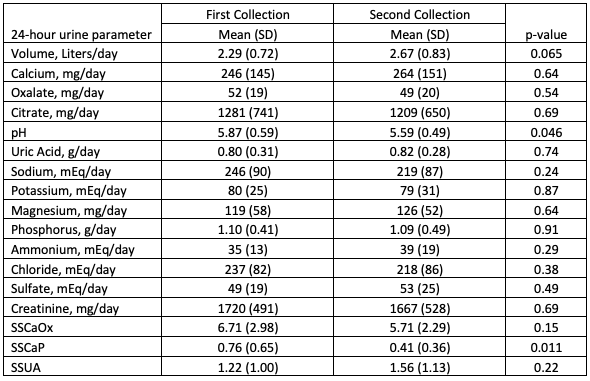Back
Introduction: Sodium/glucose cotransporter 2 inhibitors (SGLT2is) are widely used for patients with type 2 diabetes. Recent epidemiologic studies have shown a reduction in stone events in diabetic patients treated with SGLT2is, but changes in urine chemistries that may account for this have not been identified. The purpose of this study was to evaluate the effect of SGLT2is on urine chemistry and supersaturation among patients with kidney stone disease.
Methods: From a Medicare-Litholink database (years 2010-2018), we identified patients who received two, 24-hour urine tests, of which the first was performed without SGLT2i use, and the second was collected during SGLT2i use. Patients were excluded if they started using alkali citrate, thiazide, or xanthine oxidase inhibitor between the two collections, and excluded if the creatinine excretions in the 2 collections differed by >30%. Bivariate comparisons using the t-test were compared between 24-hour urine variables with p<0.05 considered statistically significant.
Results: Among 30 patients identified, the cohort had mean±SD age 66.6±8.9 years, 80% were male, and all with Medicare Part A/B available information (n=24) had a baseline diagnosis of diabetes mellitus type 2. The SGLT2i used included canagliflozin (in 56.7%), dapagliflozin (20.0%), and empagliflozin (23.3%). The mean±SD time from the first to second collection was 18.5±17.4 months. Comparison of 24-hour parameters between the first collection (pre-SGLT2i) and the second collection (on SGLT2i) is shown in the Table. Notable findings include a trend to higher 24-hour urine volume by 0.38 L/day (p=0.065), and significantly lower urine pH (p=0.046), with non-significant changes in urine excretion rate of calcium, oxalate, citrate, uric acid, and phosphorus. This resulted in a significant reduction in urine supersaturation with respect to calcium phosphate (likely from combination of greater urine volume and slightly lower pH), but non-significant changes in SS calcium oxalate and uric acid.
Conclusions: Chronic SGLT2i use is associated with a lower urine pH with non-significant changes in volume and the excretion of major stone-related electrolytes. Larger studies are needed to confirm these findings and explore the impact of SGLT2i on stone recurrence rate. SOURCE OF
Funding: Supported by National Institutes of Health Grant 1R01DK121709.

Moderated Poster Session
Session: MP10: Stone Disease: Medical & Dietary Therapy
MP10-03: Influence of SGLT2 inhibitors on 24-hour urine parameters among kidney stone patients in the Medicare population
Friday, April 28, 2023
9:30 AM – 11:30 AM CST
Location: S405

Joseph J. Crivelli, MD
University of Alabama at Birmingham School of Medicine
Poster Presenter(s)
Introduction: Sodium/glucose cotransporter 2 inhibitors (SGLT2is) are widely used for patients with type 2 diabetes. Recent epidemiologic studies have shown a reduction in stone events in diabetic patients treated with SGLT2is, but changes in urine chemistries that may account for this have not been identified. The purpose of this study was to evaluate the effect of SGLT2is on urine chemistry and supersaturation among patients with kidney stone disease.
Methods: From a Medicare-Litholink database (years 2010-2018), we identified patients who received two, 24-hour urine tests, of which the first was performed without SGLT2i use, and the second was collected during SGLT2i use. Patients were excluded if they started using alkali citrate, thiazide, or xanthine oxidase inhibitor between the two collections, and excluded if the creatinine excretions in the 2 collections differed by >30%. Bivariate comparisons using the t-test were compared between 24-hour urine variables with p<0.05 considered statistically significant.
Results: Among 30 patients identified, the cohort had mean±SD age 66.6±8.9 years, 80% were male, and all with Medicare Part A/B available information (n=24) had a baseline diagnosis of diabetes mellitus type 2. The SGLT2i used included canagliflozin (in 56.7%), dapagliflozin (20.0%), and empagliflozin (23.3%). The mean±SD time from the first to second collection was 18.5±17.4 months. Comparison of 24-hour parameters between the first collection (pre-SGLT2i) and the second collection (on SGLT2i) is shown in the Table. Notable findings include a trend to higher 24-hour urine volume by 0.38 L/day (p=0.065), and significantly lower urine pH (p=0.046), with non-significant changes in urine excretion rate of calcium, oxalate, citrate, uric acid, and phosphorus. This resulted in a significant reduction in urine supersaturation with respect to calcium phosphate (likely from combination of greater urine volume and slightly lower pH), but non-significant changes in SS calcium oxalate and uric acid.
Conclusions: Chronic SGLT2i use is associated with a lower urine pH with non-significant changes in volume and the excretion of major stone-related electrolytes. Larger studies are needed to confirm these findings and explore the impact of SGLT2i on stone recurrence rate. SOURCE OF
Funding: Supported by National Institutes of Health Grant 1R01DK121709.

